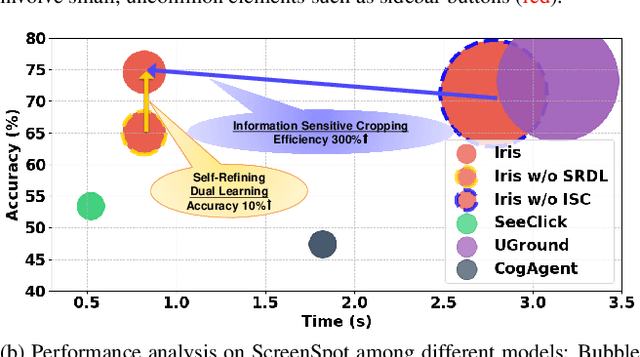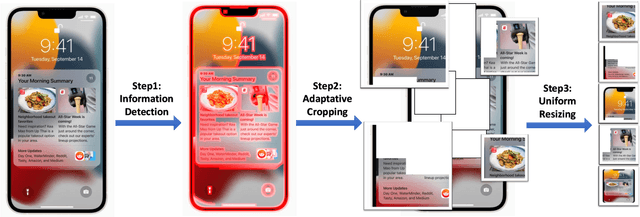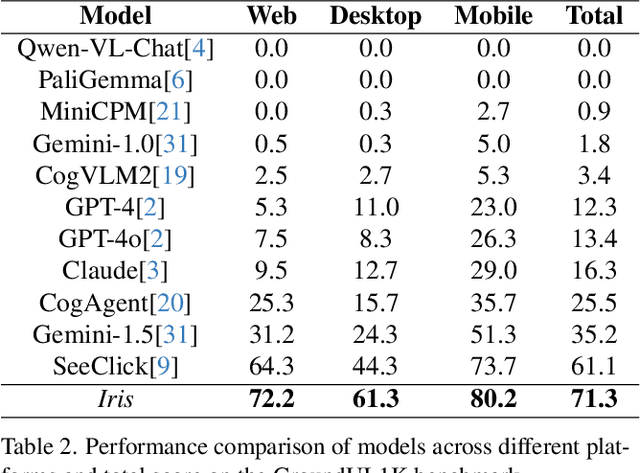Wenqiao Zhang
Boosting Virtual Agent Learning and Reasoning: A Step-wise, Multi-dimensional, and Generalist Reward Model with Benchmark
Mar 24, 2025Abstract:The development of Generalist Virtual Agents (GVAs) powered by Multimodal Large Language Models (MLLMs) has shown significant promise in autonomous task execution. However, current training paradigms face critical limitations, including reliance on outcome supervision and labor-intensive human annotations. To address these challenges, we propose Similar, a Step-wise Multi-dimensional Generalist Reward Model, which offers fine-grained signals for agent training and can choose better action for inference-time scaling. Specifically, we begin by systematically defining five dimensions for evaluating agent actions. Building on this framework, we design an MCTS-P algorithm to automatically collect and annotate step-wise, five-dimensional agent execution data. Using this data, we train Similar with the Triple-M strategy. Furthermore, we introduce the first benchmark in the virtual agent domain for step-wise, multi-dimensional reward model training and evaluation, named SRM. This benchmark consists of two components: SRMTrain, which serves as the training set for Similar, and SRMEval, a manually selected test set for evaluating the reward model. Experimental results demonstrate that Similar, through its step-wise, multi-dimensional assessment and synergistic gain, provides GVAs with effective intermediate signals during both training and inference-time scaling. The code is available at https://github.com/Galery23/Similar-v1.
SOYO: A Tuning-Free Approach for Video Style Morphing via Style-Adaptive Interpolation in Diffusion Models
Mar 10, 2025Abstract:Diffusion models have achieved remarkable progress in image and video stylization. However, most existing methods focus on single-style transfer, while video stylization involving multiple styles necessitates seamless transitions between them. We refer to this smooth style transition between video frames as video style morphing. Current approaches often generate stylized video frames with discontinuous structures and abrupt style changes when handling such transitions. To address these limitations, we introduce SOYO, a novel diffusion-based framework for video style morphing. Our method employs a pre-trained text-to-image diffusion model without fine-tuning, combining attention injection and AdaIN to preserve structural consistency and enable smooth style transitions across video frames. Moreover, we notice that applying linear equidistant interpolation directly induces imbalanced style morphing. To harmonize across video frames, we propose a novel adaptive sampling scheduler operating between two style images. Extensive experiments demonstrate that SOYO outperforms existing methods in open-domain video style morphing, better preserving the structural coherence of video frames while achieving stable and smooth style transitions.
Think Twice, Click Once: Enhancing GUI Grounding via Fast and Slow Systems
Mar 09, 2025Abstract:Humans can flexibly switch between different modes of thinking based on task complexity: from rapid intuitive judgments to in-depth analytical understanding. However, current Graphical User Interface (GUI) grounding systems which locate interface elements based on natural language instructions rely solely on immediate prediction without reasoning, struggling to understand complex interface layouts with nested structures and hierarchical relationships, limiting their effectiveness on complex interfaces. Inspired by human dual-system cognition, we present Focus, a novel GUI grounding framework that combines fast prediction with systematic analysis. The framework dynamically switches between rapid and deliberate processing through an adaptive system switching based on task complexity, optimizing both efficiency and accuracy. Focus decomposes grounding into progressive stages: interface summarization, visual focused analysis, and precise coordinate prediction. This structured decomposition enables systematic understanding of both interface layouts and visual relationships. Extensive experiments show that Focus achieves state-of-the-art performance using only 300K of the training data with a 2B parameter model compared to existing approaches. Focus demonstrates superior performance particularly in complex GUI scenarios, achieving 77.4% average accuracy on ScreenSpot and 13.3% on the more challenging ScreenSpot-Pro. Our analysis reveals the effectiveness of this dual-system approach while demonstrating its potential for improving complex GUI interaction scenarios.
Optimize Incompatible Parameters through Compatibility-aware Knowledge Integration
Jan 10, 2025



Abstract:Deep neural networks have become foundational to advancements in multiple domains, including recommendation systems, natural language processing, and so on. Despite their successes, these models often contain incompatible parameters that can be underutilized or detrimental to model performance, particularly when faced with specific, varying data distributions. Existing research excels in removing such parameters or merging the outputs of multiple different pretrained models. However, the former focuses on efficiency rather than performance, while the latter requires several times more computing and storage resources to support inference. In this paper, we set the goal to explicitly improve these incompatible parameters by leveraging the complementary strengths of different models, thereby directly enhancing the models without any additional parameters. Specifically, we propose Compatibility-aware Knowledge Integration (CKI), which consists of Parameter Compatibility Assessment and Parameter Splicing, which are used to evaluate the knowledge content of multiple models and integrate the knowledge into one model, respectively. The integrated model can be used directly for inference or for further fine-tuning. We conduct extensive experiments on various datasets for recommendation and language tasks, and the results show that Compatibility-aware Knowledge Integration can effectively optimize incompatible parameters under multiple tasks and settings to break through the training limit of the original model without increasing the inference cost.
Collaboration of Large Language Models and Small Recommendation Models for Device-Cloud Recommendation
Jan 10, 2025Abstract:Large Language Models (LLMs) for Recommendation (LLM4Rec) is a promising research direction that has demonstrated exceptional performance in this field. However, its inability to capture real-time user preferences greatly limits the practical application of LLM4Rec because (i) LLMs are costly to train and infer frequently, and (ii) LLMs struggle to access real-time data (its large number of parameters poses an obstacle to deployment on devices). Fortunately, small recommendation models (SRMs) can effectively supplement these shortcomings of LLM4Rec diagrams by consuming minimal resources for frequent training and inference, and by conveniently accessing real-time data on devices. In light of this, we designed the Device-Cloud LLM-SRM Collaborative Recommendation Framework (LSC4Rec) under a device-cloud collaboration setting. LSC4Rec aims to integrate the advantages of both LLMs and SRMs, as well as the benefits of cloud and edge computing, achieving a complementary synergy. We enhance the practicability of LSC4Rec by designing three strategies: collaborative training, collaborative inference, and intelligent request. During training, LLM generates candidate lists to enhance the ranking ability of SRM in collaborative scenarios and enables SRM to update adaptively to capture real-time user interests. During inference, LLM and SRM are deployed on the cloud and on the device, respectively. LLM generates candidate lists and initial ranking results based on user behavior, and SRM get reranking results based on the candidate list, with final results integrating both LLM's and SRM's scores. The device determines whether a new candidate list is needed by comparing the consistency of the LLM's and SRM's sorted lists. Our comprehensive and extensive experimental analysis validates the effectiveness of each strategy in LSC4Rec.
VideoRefer Suite: Advancing Spatial-Temporal Object Understanding with Video LLM
Jan 08, 2025Abstract:Video Large Language Models (Video LLMs) have recently exhibited remarkable capabilities in general video understanding. However, they mainly focus on holistic comprehension and struggle with capturing fine-grained spatial and temporal details. Besides, the lack of high-quality object-level video instruction data and a comprehensive benchmark further hinders their advancements. To tackle these challenges, we introduce the VideoRefer Suite to empower Video LLM for finer-level spatial-temporal video understanding, i.e., enabling perception and reasoning on any objects throughout the video. Specially, we thoroughly develop VideoRefer Suite across three essential aspects: dataset, model, and benchmark. Firstly, we introduce a multi-agent data engine to meticulously curate a large-scale, high-quality object-level video instruction dataset, termed VideoRefer-700K. Next, we present the VideoRefer model, which equips a versatile spatial-temporal object encoder to capture precise regional and sequential representations. Finally, we meticulously create a VideoRefer-Bench to comprehensively assess the spatial-temporal understanding capability of a Video LLM, evaluating it across various aspects. Extensive experiments and analyses demonstrate that our VideoRefer model not only achieves promising performance on video referring benchmarks but also facilitates general video understanding capabilities.
MAKIMA: Tuning-free Multi-Attribute Open-domain Video Editing via Mask-Guided Attention Modulation
Dec 28, 2024



Abstract:Diffusion-based text-to-image (T2I) models have demonstrated remarkable results in global video editing tasks. However, their focus is primarily on global video modifications, and achieving desired attribute-specific changes remains a challenging task, specifically in multi-attribute editing (MAE) in video. Contemporary video editing approaches either require extensive fine-tuning or rely on additional networks (such as ControlNet) for modeling multi-object appearances, yet they remain in their infancy, offering only coarse-grained MAE solutions. In this paper, we present MAKIMA, a tuning-free MAE framework built upon pretrained T2I models for open-domain video editing. Our approach preserves video structure and appearance information by incorporating attention maps and features from the inversion process during denoising. To facilitate precise editing of multiple attributes, we introduce mask-guided attention modulation, enhancing correlations between spatially corresponding tokens and suppressing cross-attribute interference in both self-attention and cross-attention layers. To balance video frame generation quality and efficiency, we implement consistent feature propagation, which generates frame sequences by editing keyframes and propagating their features throughout the sequence. Extensive experiments demonstrate that MAKIMA outperforms existing baselines in open-domain multi-attribute video editing tasks, achieving superior results in both editing accuracy and temporal consistency while maintaining computational efficiency.
Boosting Private Domain Understanding of Efficient MLLMs: A Tuning-free, Adaptive, Universal Prompt Optimization Framework
Dec 27, 2024Abstract:Efficient multimodal large language models (EMLLMs), in contrast to multimodal large language models (MLLMs), reduce model size and computational costs and are often deployed on resource-constrained devices. However, due to data privacy concerns, existing open-source EMLLMs rarely have access to private domain-specific data during the pre-training process, making them difficult to directly apply in device-specific domains, such as certain business scenarios. To address this weakness, this paper focuses on the efficient adaptation of EMLLMs to private domains, specifically in two areas: 1) how to reduce data requirements, and 2) how to avoid parameter fine-tuning. Specifically, we propose a tun\textbf{\underline{I}}ng-free, a\textbf{\underline{D}}aptiv\textbf{\underline{E}}, univers\textbf{\underline{AL}} \textbf{\underline{Prompt}} Optimization Framework, abbreviated as \textit{\textbf{\ourmethod{}}} which consists of two stages: 1) Predefined Prompt, based on the reinforcement searching strategy, generate a prompt optimization strategy tree to acquire optimization priors; 2) Prompt Reflection initializes the prompt based on optimization priors, followed by self-reflection to further search and refine the prompt. By doing so, \ourmethod{} elegantly generates the ``ideal prompts'' for processing private domain-specific data. Note that our method requires no parameter fine-tuning and only a small amount of data to quickly adapt to the data distribution of private data. Extensive experiments across multiple tasks demonstrate that our proposed \ourmethod{} significantly improves both efficiency and performance compared to baselines.
Meta-Reflection: A Feedback-Free Reflection Learning Framework
Dec 18, 2024



Abstract:Despite the remarkable capabilities of large language models (LLMs) in natural language understanding and reasoning, they often display undesirable behaviors, such as generating hallucinations and unfaithful reasoning. A prevalent strategy to mitigate these issues is the use of reflection, which refines responses through an iterative process. However, while promising, reflection heavily relies on high-quality external feedback and requires iterative multi-agent inference processes, thus hindering its practical application. In this paper, we propose Meta-Reflection, a novel feedback-free reflection mechanism that necessitates only a single inference pass without external feedback. Motivated by the human ability to remember and retrieve reflections from past experiences when encountering similar problems, Meta-Reflection integrates reflective insights into a codebook, allowing the historical insights to be stored, retrieved, and used to guide LLMs in problem-solving. To thoroughly investigate and evaluate the practicality of Meta-Reflection in real-world scenarios, we introduce an industrial e-commerce benchmark named E-commerce Customer Intent Detection (ECID). Extensive experiments conducted on both public datasets and the ECID benchmark highlight the effectiveness and efficiency of our proposed approach.
Iris: Breaking GUI Complexity with Adaptive Focus and Self-Refining
Dec 13, 2024



Abstract:Digital agents are increasingly employed to automate tasks in interactive digital environments such as web pages, software applications, and operating systems. While text-based agents built on Large Language Models (LLMs) often require frequent updates due to platform-specific APIs, visual agents leveraging Multimodal Large Language Models (MLLMs) offer enhanced adaptability by interacting directly with Graphical User Interfaces (GUIs). However, these agents face significant challenges in visual perception, particularly when handling high-resolution, visually complex digital environments. This paper introduces Iris, a foundational visual agent that addresses these challenges through two key innovations: Information-Sensitive Cropping (ISC) and Self-Refining Dual Learning (SRDL). ISC dynamically identifies and prioritizes visually dense regions using a edge detection algorithm, enabling efficient processing by allocating more computational resources to areas with higher information density. SRDL enhances the agent's ability to handle complex tasks by leveraging a dual-learning loop, where improvements in referring (describing UI elements) reinforce grounding (locating elements) and vice versa, all without requiring additional annotated data. Empirical evaluations demonstrate that Iris achieves state-of-the-art performance across multiple benchmarks with only 850K GUI annotations, outperforming methods using 10x more training data. These improvements further translate to significant gains in both web and OS agent downstream tasks.
 Add to Chrome
Add to Chrome Add to Firefox
Add to Firefox Add to Edge
Add to Edge